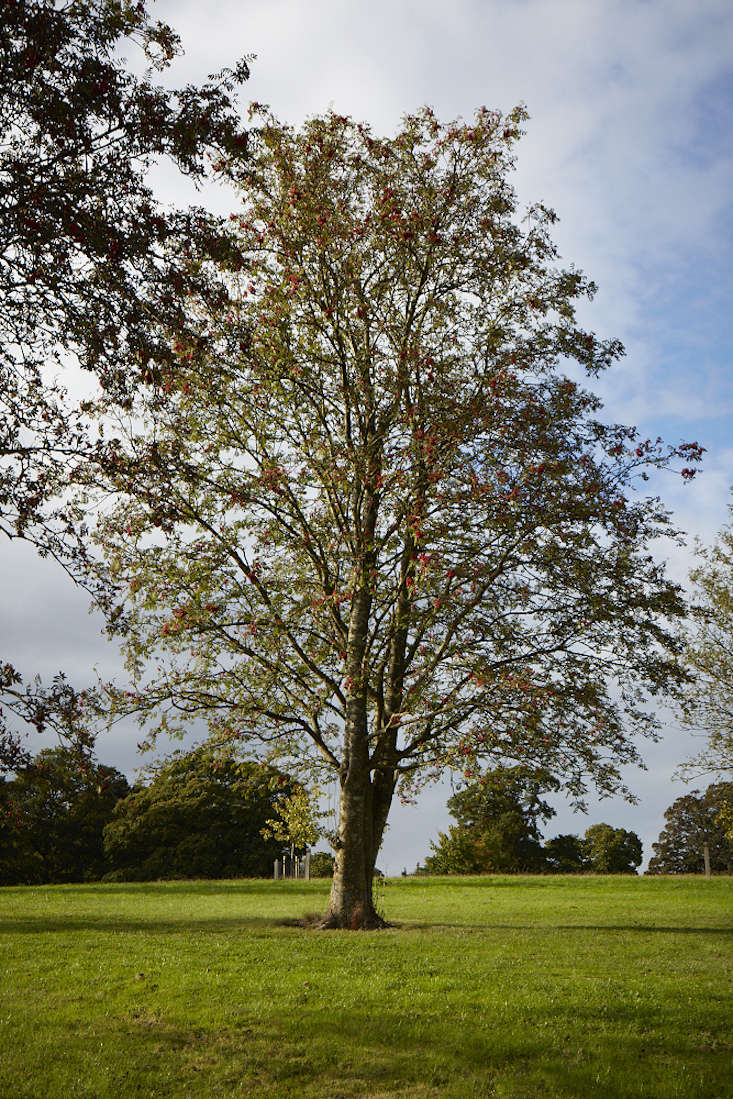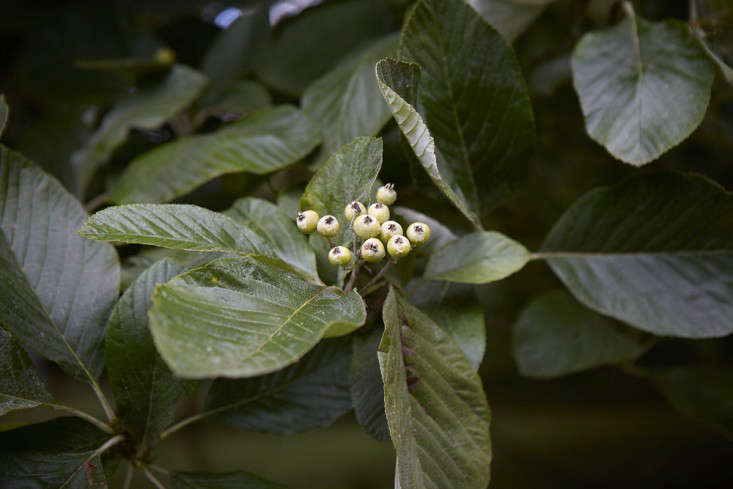Sorbus (aka Rowan or Mountain Ash): “The Protector”
Sorbus is pleasant enough in summer, with its distinctive pinnate leaves and agreeable shape and size. It is in fall when these smallish trees become unmissable, with bunches of orange, streaky pink or white berries glowing in the darkening skies. Common rowan (Sorbus aucuparia), seen along roadsides and in gardens, has berries that are red; the best color for warding off evil, particularly in the form of witches.
Photography by Britt Willoughby Dyer for Gardenista.
Above: Sorbus commixta, S. ‘Joseph Rock’ and S. ‘Apricot Queen’ have good yellow-to-orange berries and contrasting foliage until the leaves announce their imminent departure by turning a red-orange themselves.
Above: Sorbus aucuparia, common rowan or, sometimes, “the Wizard’s Tree”. The wood of rowan is traditionally used for dowsing rods, in divining metal, water, or other energies. Even the form of each fruit is symbolic, with a five-pointed star at its base. The pentagram is a magical symbol; bad if it’s pointing downwards.
Above: Although Sorbus is known as mountain ash, it has nothing to do with the ash tree (Fraxinus excelsior), besides a resemblance in the leaves. To avoid confusion, stick with Sorbus or rowan.
Above: Pink, white, or pink-stained berries tend to remain after the leaves have dropped off, giving the trees an even more magical quality. Sorbus carmesina (shown here) is a good variety with a sophisticated color scheme, as is pearly Sorbus rosea. Sorbus pseudohupehenis is a favorite white-berried variety, stained pink around the pentagram and stalks.
Above: Sorbus aria, better known as whitebeam. With its simple leaves, it is one of about 100 different species of Sorbus. In spring the leaves’ felty white undersides shimmer in the breeze, giving the whitebeam canopy a silvery appearance. Another Sorbus family member is the wild service tree (Sorbus torminalis), with pinnately lobed leaves.
Cheat Sheet
• Red and orange berries of the common rowan are a good food source for birds, particularly blackbird, fieldfare, mistle thrush, and song thrush.
• The pink and white berries of Chinese varieties are less interesting as food. In early spring the berries make a striking combination with hellebores and bulbs.
• Sorbus is very hardy and unfussy. Combined with the compact size of many varieties, it is an ideal tree for small urban gardens.
Keep It Alive
• Common rowan is at home in cooler temperatures and grows well at altitude, hence its alternative name of mountain ash. Because its seeds readily germinate, common rowan can be seen growing out of unlikely rocky crags, exposed and bearing up to the chill.
• Sorbus species prefer more comfortable conditions, e.g. fertile soil in sun or dappled shade. They are not so keen on excess damp, though whitebeam and wild service tree tolerate heavier soil.
• The main enemy to Sorbus is fire blight, a bacterial disease that causes branch die back and leaf scorching. The only solution is to replace the tree.
Above: Sorbus carmesina. There is enough variety within the Sorbus genus to choose between tall and cool or small and fiery.
Sorbus adds to the fall palette on both sides of the Atlantic. See also:
11 Best Trees to Plant for New England-Style Foliage.
A Gothic Garden Visit, Courtesy of the Mitfords.
N.B.: Are you trying to decide which tree to add to your landscape? See our Garden Design 101 guides, specifically Trees: A Field Guide to Planting, Care, and Design. If you need something smaller, see Shrubs: A Field Guide.

















Have a Question or Comment About This Post?
Join the conversation